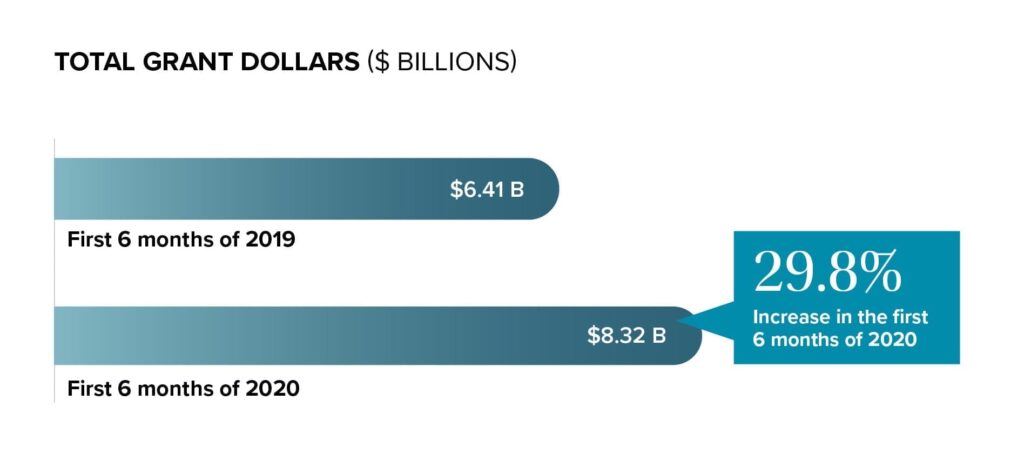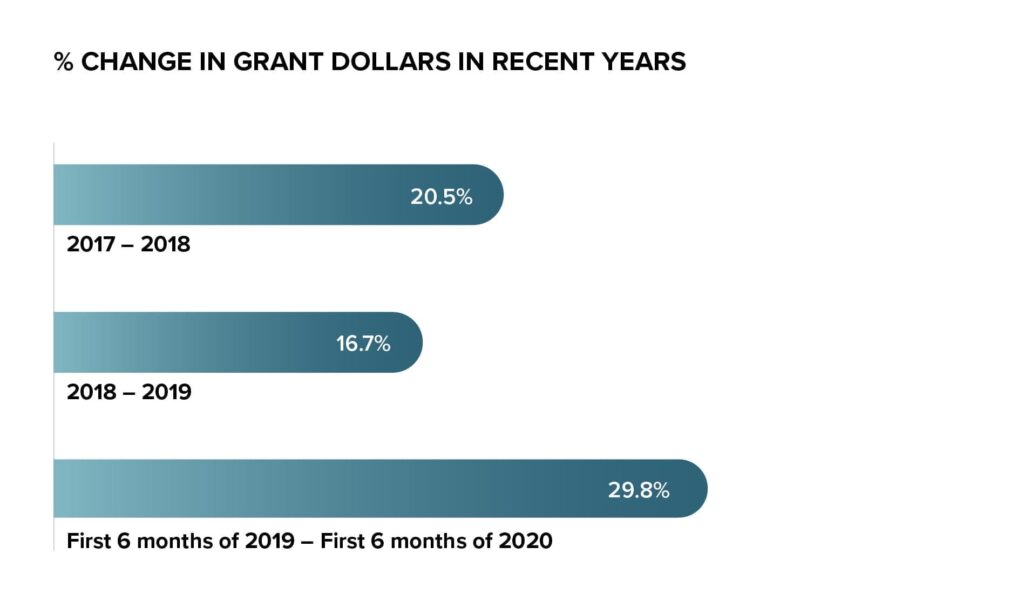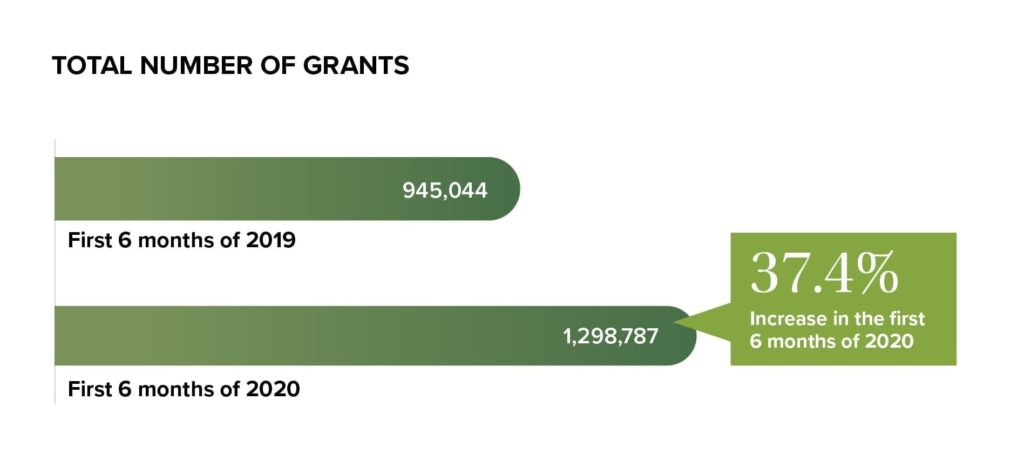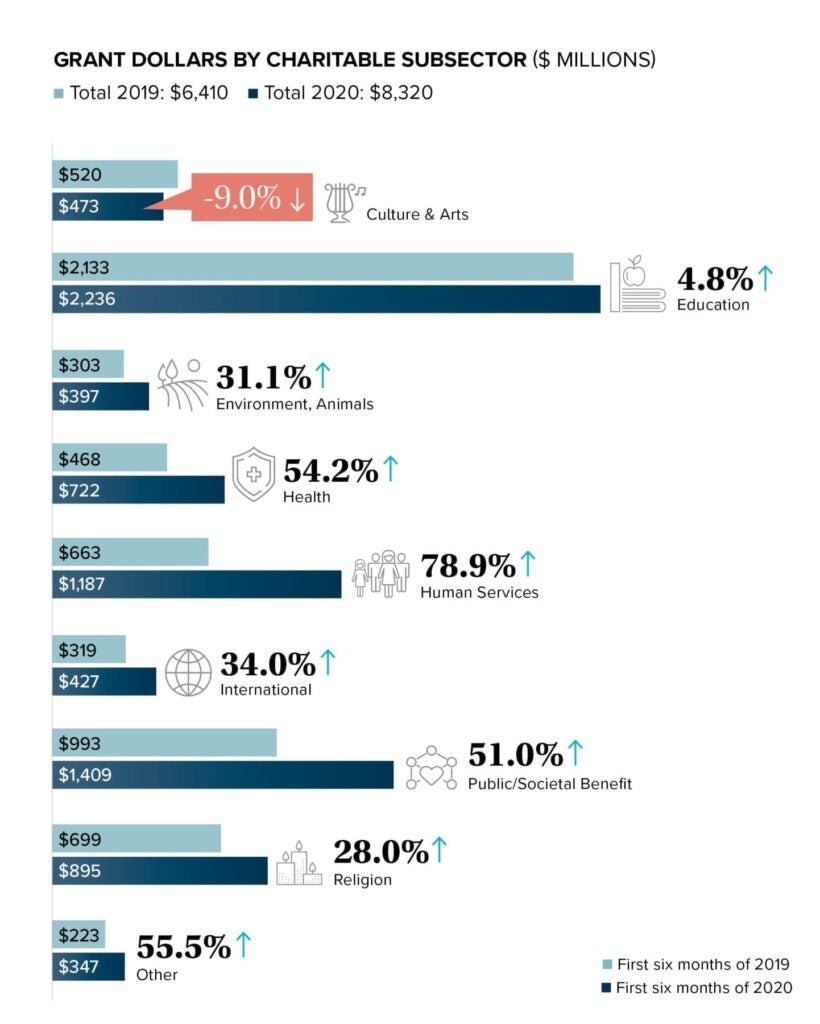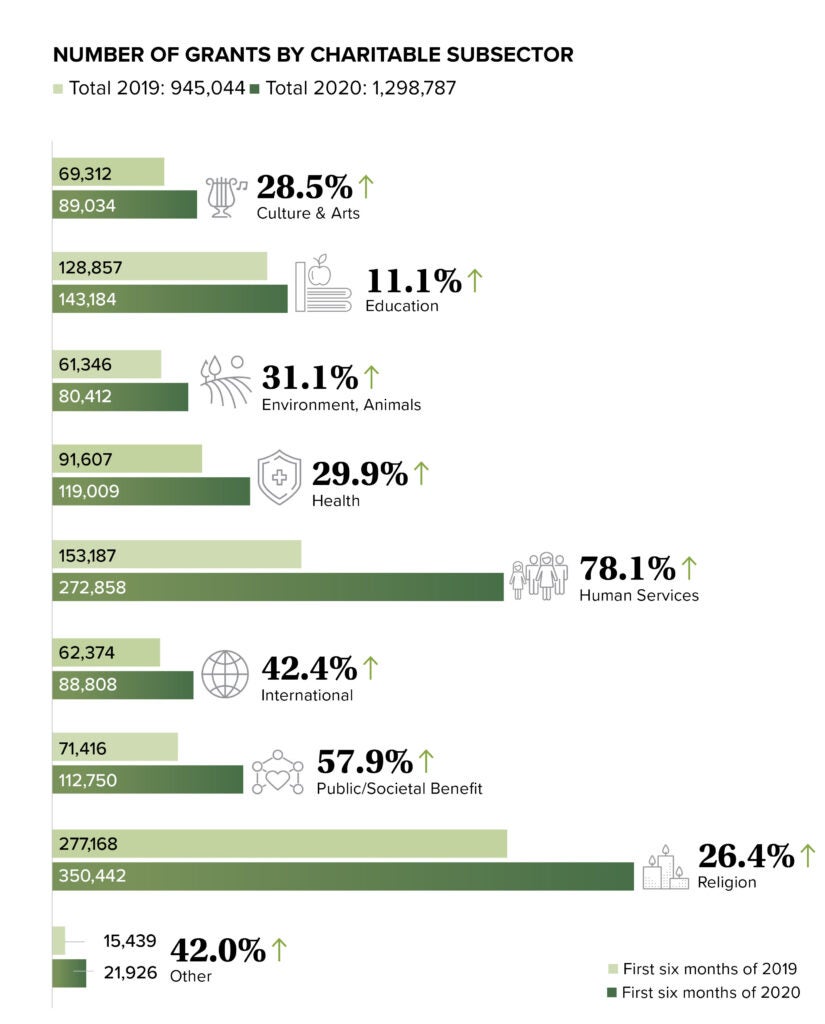Introduction
National Philanthropic Trust is pleased to present the Donor-Advised Fund COVID Grantmaking Survey. This survey reflects self-reported data from donor-advised fund (DAF) sponsors on the DAF philanthropic response to the COVID-19 pandemic as it emerged in the first half of 2020. It is the first aggregate analysis of data from different types of DAF sponsors during COVID-19. The survey is being published alongside our 2020 Donor-Advised Fund Report, an annual analysis of donor-advised fund statistics and the giving landscape. The Donor-Advised Fund Report provides a historical look at DAF growth and can serve as a benchmark with this survey. However, the data samples and methodologies are separate and distinct.
______________________________________
About This Survey
The global COVID-19 pandemic started in December 2019 and has had tremendous direct and indirect impact on our communities over the past year. At the time of publication, more than 100 million people have been diagnosed with this novel coronavirus and, tragically, two million have died. In the United States and around the world, we have faced important questions, from how to equip frontline healthcare workers with personal protective equipment to the best ways to supply students with technology for remote learning.
In spite of the chaos and heartbreak, the pandemic has underscored a simple fact:
People care deeply about each other.
In the United States, the philanthropic response to COVID-19 has been astounding. Charitable Americans have supported crisis service organizations, research institutions working to find a vaccine, personal fundraisers for the sick or unemployed and community-based groups serving the most vulnerable. Donor-advised fund (DAF) donors have responded generously to these and other causes during the pandemic. In the following pages, you will learn about their exceptional response to this exceptional time.
I wish to send my sincerest thanks and admiration to National Philanthropic Trust’s fellow DAF sponsors for participating in this survey. As DAF activity increased to historic levels, I am conscious of and grateful for the time and resources it took to self-report this additional data. At NPT, we are inspired by the work of our peers and by our collective DAF donors’ response to support communities across the country and beyond.
Eileen R. Heisman
President and CEO
Executive Summary
National Philanthropic Trust’s DAF COVID Grantmaking Survey found that DAF donors responded urgently to the COVID-19 crisis as it impacted the health and well-being of their communities.
DAF donors and sponsors increased grantmaking support for all types of charities. There are eight charitable subsectors—categories that charities use to define their core mission like arts, health and education. All eight of these subsectors (and a very small category of “other”) all received more grants in the first half of 2020 than they did in the first half of 2019. This is particularly interesting because it signals that DAF donors did not necessarily shift their giving priorities amid the global pandemic, rather they continued to support many of the same causes they supported before COVID-19 and met emerging and urgent needs that arose.
Grant data highlights from the survey include:
- DAF grants to charitable organizations increased 29.8 percent by dollar value in the first six months of 2020 compared to the first six months of 2019.
- DAF grants to charitable organizations increased 37.4 percent by grant volume when comparing the same periods.
- DAF donors recommended the most grant dollars to organizations in the education charitable subsector both years, but the human services subsector experienced the highest increase at 78.9 percent in early 2020 as compared to early 2019.
- DAF donors recommended the highest number of grants to religious organizations in both years, but here too charities in the human services subsector experienced the largest increase, receiving 78.1 percent more DAF grants in the first half of 2020 than in the first half of 2019.
Findings
Grant Dollars Increased Significantly at the Onset of COVID-19
Grants from DAFs to qualified charities rose 29.8 percent, from $6.41 billion in the first six months of 2019 to $8.32 billion for the same period in 2020. As a point of comparison, this rate of growth is nearly double the 16.7 percent increase from fiscal year 2018 to fiscal year 2019 for the same DAF sponsors.[1]
[1] NPT collects grantmaking dollar data as part of the annual Donor-Advised Fund Report and was able to use the database to calculate historical comparisons.
Number of Grants Increased More Than a Third as COVID-19 Emerged
The total number of DAF grants increased by 37.4 percent, from 945,044 grants in the first half of 2019 to 1,298,787 in the first six months of 2020. There is no data available for prior year-to-year comparisons as DAF sponsors do not report the number of grants they make on their IRS Form 990, which is publicly available. For this special survey, we asked for this datapoint from the participating DAF sponsors for the first six months of each year, 2019 and 2020.
Grant Dollars Increased to Almost Every Charitable Subsector
Grant dollars, which increased 29.8 percent in total, increased to organizations in every charitable subsector except arts.
Grants to charities in the arts subsector declined 9.0%, from $520 million in the first six months of 2019 to $474 million in the same period in 2020. The arts charitable subsector can include museums, performing arts groups and historical societies.
Grant dollars rose by 78.9 percent to human services charities from $663 million to $1.19 billion. This rate of growth is nearly the same as the increase in the number of grants (up 78.1 percent), which means that the average grant value to human services organizations remained about the same (a 0.4 percent increase). The human services charitable subsector can include food distribution groups, homeless shelters and public safety organizations.
Grant dollars rose by 54.2 percent to charities in the health subsector, from $468 million to $722 million. Among these surveyed DAF sponsors, the average grant amount for health charities increased by 18.7 percent. The health subsector can include disease research institutions, healthcare facilities and mental health and crisis service organizations.
Number of Grants Increased to All Charitable Subsectors
Overall, the number of grants increased from 945,044 grants in early 2019 to 1,298,787 in early 2020, a 37.4 percent increase.
The number of grants rose for every charitable subsector. The most significant change was the increase in grants to charities in the human services subsector, which rose by 78.1 percent.
The second highest increase in grant number was a 57.9 percent increase to the public/societal benefit subsector, which includes many community-based organizations that organized special COVID-19 emergency funds within local areas. The human services subsector includes charities like United Ways, housing alliances and professional associations. Civil rights organizations and voter education and registration charities, which were highly relevant in 2020, also fall into this subsector.
The number of grants to religious organizations was highest among all charitable sponsors in the first half of 2019 at 277,168 grants and remained the highest as it rose to 350,442 grants in the first half of 2020. This change represents a 26.4 percent increase in grants to religious organizations, many of which provide food pantries, emergency financial assistance, counseling and other services accessed in crisis.
Observations
NPT’s DAF COVID Grantmaking Survey findings show that DAF donors and their DAF sponsors increased grantmaking support for all charities in the earliest months of the COVID-19 pandemic. Organizations in all charitable subsectors received more grants from DAFs and all-but-one received more grant dollars—a clear indication that DAF donors sustained support for their favorite charitable organizations and met new needs that resulted from COVID-19.
It is important to note that the time period analyzed in this survey—the first six months of 2020—does not reflect the full impact of the pandemic or the other events of 2020, most notably the fight against racial inequity. Data from the second half of 2020 and even the earliest weeks of 2021 are likely to show sustained growth in DAF grantmaking.
Historically, DAF grantmaking has grown at a tremendous rate. As reported in our most recent Donor-Advised Fund Report, total grants from DAFs to qualified charities have nearly doubled in the last five years alone, an indicator of DAF donors’ long-term commitment to philanthropy. When coupled with the data in this special survey—which shows a committed and immediate response from DAF donors to the global pandemic—it is reasonable to assume that DAF donors and sponsors will continue to be a sustainable resource for all types of charitable causes.
Methodology
This Donor-Advised Fund COVID Grantmaking Survey was conducted among 13 DAF sponsors using self-reported data at the end of 2020. Collectively, this group represents just under 50 percent of total DAF charitable grant dollars disbursed annually and includes national charities and community foundation DAF sponsors.
National Philanthropic Trust analyzed the limited data set of survey respondents and used different methodology than NPT’s annual Donor-Advised Fund Report. The Donor-Advised Fund Report estimates values based on historical trends where data cannot be collected. This survey relies only on available data and does not attempt to estimate where data points were not provided by respondents.
The 2020 DAF Report
Now in its 14th year, NPT’s 2020 Donor-Advised Fund (DAF) Report is an annual industry report consisting of comprehensive data on donor-advised funds in the United States. To read the full report, click here.
